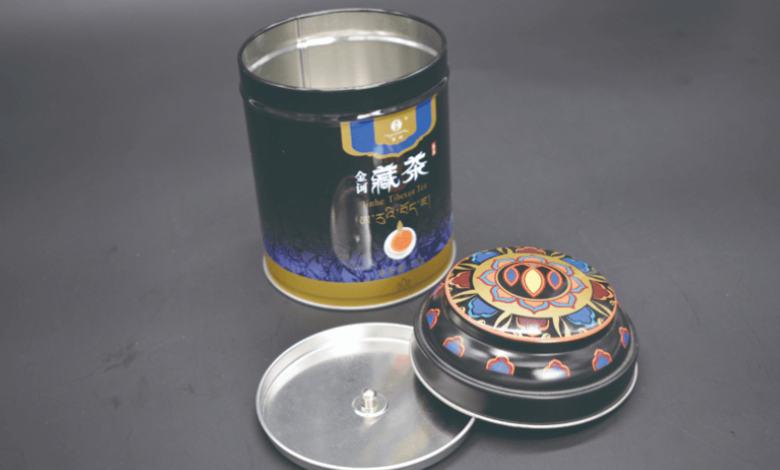Why do European tea producers insist on using sealed tea tins?

In Europe’s historic tea-producing regions, from the rolling tea gardens of England to the handcrafted blends of Germany and Scandinavia, producers consistently choose sealed tea tins to package their finest blends. These tins do more than showcase an elegant brand image; they preserve the delicate flavor of tea, protect against environmental factors, and communicate its quality. We’ll use our experience working with European customers to explain why they prefer sealed tea tins for humidity control, freshness, UV protection, fragrance retention, brand story, and sustainability.
Tea tins for humidity control and extended shelf life
Moisture is the enemy of premium tea, causing it to oxidize, mold, and reduce its flavor. That’s why European tea producers choose sealed tea tins designed for humidity control—with precision-fitting lids and resilient gaskets that form an airtight barrier. These moisture-proof tins prevent ambient moisture from penetrating the packaging, thereby maintaining the tea’s optimal moisture content of 2-3%. By keeping it dry, sealed tins extend the shelf life of tea from months to years without artificial preservatives. Qingxing’s shelf life studies show that tea leaves stored in high-quality sealed tea tins retain more than 85% of their antioxidant properties and aromatic compounds after one year, while tea leaves stored in loose plastic bags retain less than 50%.
Tea tins for freshness preservation and oxidation prevention
Oxidation not only fades the color of tea leaves but also weakens their delicate flavors, with delicate floral and light fruity aromas quickly dissipating after exposure to oxygen. Sealed tea tins with oxygen barrier coatings provide excellent sealing, reducing oxygen penetration to less than one cubic centimeter per square meter daily. In addition, for specialty teas such as Darjeeling or white tea, where freshness is important, these oxygen-barrier tins can preserve the original terroir flavor of the tea. European producers, especially those in the high-end tea market, such as France and Switzerland, always choose tea tins that meet strict oxygen transmission rate (OTR) standards to ensure every cup of tea has the expected rich taste and vitality.
See also The Future of Trading: Leveraging Instant Access to Professional Resources
Light-proof and UV-proof tea tins
Ultraviolet (UV) radiation changes the structure of chlorophyll and polyphenols in tea leaves, causing the tea leaves to change flavor and color. Protect tea stored on bright retail shelves or in sunny farmhouse kitchens by completely blocking visible and UV light with opaque sealed tins. Many European brands use glossy or matte metal tins that reflect up to 95% of incident light. Some tea tins have a lacquer formula with UV inhibitors on the inside, adding an extra layer of protection for the tea. Producers can use these light-blocking tins to ensure that delicate green teas and matcha powders retain their vibrant color and fresh taste even after long shelf life.
For aroma retention and odor blocking
Tea aroma is very fragile and easily dissipated. To prevent aroma loss, sealed tins with an aroma barrier layer maintain a closed-loop microenvironment. Advanced tin linings, such as multi-layer epoxy, block the escape of volatile compounds while resisting the intrusion of oils and moisture. European artisan tea houses in the UK and Belgium frequently conduct sensory tests on tea stored in these aroma-sealed tins. Results show that aroma retention is still above 90% after three months, while aroma retention in standard paper tubes is less than 60%. This ensures that every unboxing experience, from opening a can of oolong to tasting a spiced tea, delivers the full olfactory richness that tea blenders desire.
Building premium brands and enhancing consumer experience
In addition to technical performance, customization can enhance brand prestige and give tea tins a tactile and visual experience. Through European tea producers working with tea tin manufacturers, various designs can be customized, including embossed patterns, gold stamping and limited edition artwork, making each tea can a collector’s item. On the other hand, the weight and click of a well-sealed tea can convey exquisite craftsmanship and authenticity. Many brands add information panels or customized tea spoons inside the can to enhance user engagement. Manufacturers can make their products more differentiated, enhance premium competitiveness, and promote repeat purchases by investing in custom-designed sealed tea cans.
See also The Future of Trading: Leveraging Instant Access to Professional Resources
Ultimately
European tea producers’ strong preference for sealed tea tins stems from several factors, including technical performance, brand benefits, sustainability considerations, and regulatory compliance. The sealed tea cans’ moisture and oxygen-proof, UV-proof, aroma-preserving seal, high-end design, reusable materials, and strict food safety certification work together to ensure the quality of the tea from planting to final drinking.





